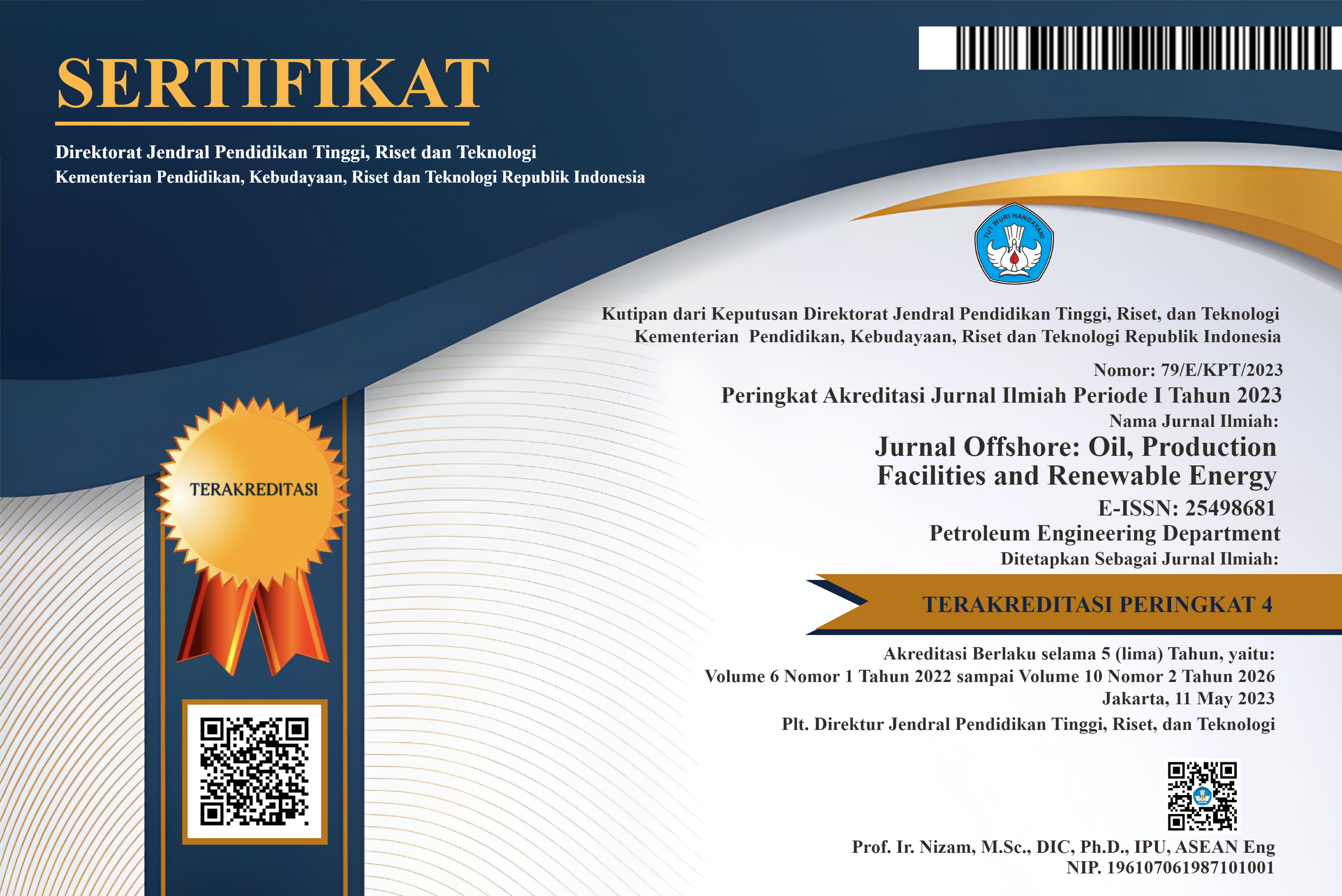Analisis PASTEL & SWOTPemanfaatan Teknologi Pumped Storage Hydropower Untuk Meningkatan Penetrasi Energi Terbarukan Di Indonesia
DOI:
https://doi.org/10.30588/jo.v6i1.1012Keywords:
Renewable energy, Pumped storage hydropower, PASTEL, SWOTAbstract
Renewable energy (RE) power plants can reduce the use of fossil fuel power plants that damage the environment related to CO2 emissions. Solar power centers and wind/wind power plants (PLTB) have intermittent characteristics related to their performance which is strongly influenced by environmental conditions such as fluctuations in solar radiation & wind speed. This creates problems in the stability & reliability of the electricity system so that its utilization is not optimal. Pumped storage hydropower (PSH) is a renewable energy-based technology that can store excess energy production in the electricity system at low load conditions to be distributed when the system is in peak load conditions. This study aims to determine the use of PSH concerning increasing the penetration of RE generators in the electricity system. Pastel & SWOT (Strength Weakness Opportunity Threat) analysis methods were used in this study. From the results of the discussion & discussion, it was found that PSH technology can support the penetration of RE power plants in Indonesia, especially PLTB & PLTS because it can eliminate the intermittency nature of these plants in the electricity system. In addition, PSH is also a mature energy storage medium on a large & economical scale, making it suitable for application in large & complex electrical systems. The strength of PSH is its mature technology, especially from the aspect of its large and economical capacity. The weakness of PSH is related to its utilization depending on the location due to the need for the area to have sufficient water potential with hilly natural conditions (their elevation), and relatively large land. The opportunity offered by PSH is that Indonesia has many areas that have the potential to be developed into PSH. In addition, the use of PSH can reduce the cost of production and increase the penetration of PLTS & PLTB. The threat of PSH is the trend of decreasing storage costs & increasing battery performance.
References
Abdullah, Fathi S.M. (2009). PESTEL Framework and Porter’s Five Forces Model.
Arena. (2017). What is pumped hydro and how does it work?.
Bin Lu. (2021) Low-cost, low-emission 100% renewable electricity in Southeast Asia supported by pumped hydro storage. Energy 236.
Bozalakov D., Mnati M.J., Laveyne J., Desmet J., Vandevelde L. (2019) Battery storage integration in voltage unbalance and overvoltage mitigation control strategies and its impact on the power quality. Energies 12 1501.
Bozalakov D.V., Laveyne J., Mnati MJ, Van de Vyver J, Vandevelde L. (2020). Possible Power Quality Ancillary Services in Low-Voltage Grids Provided by the Three-Phase Damping Control Strategy. Appl. Sci. 10 7876.
Deane, J. Paul, BP Ó. Gallachóir, and E. J. McKeogh. (2010). Techno-economic review of existing and new pumped hydro energy storage plant.Renewable and Sustainable Energy Reviews 14, no. 4, pp 1293-1302.
Etzioni A. (1968). Social Analysis and Social Action. American Behavioral Scientist. 12(1):31-33. doi:10.1177/000276426801200107.
Fitzgerald, J. P., E. A. Cooper, and F. P. Solomon. (1973). Operation of seneca pumped storage plant." IEEE Transactions on Power Apparatus and Systems 5 (1973): 1510-1516.
Florian Ion Tiberiu Petrescu. (2015). Hydropower and Pumped-Storage.
Heptonstall P., Gross R, Steiner F,. (2016). The Costs and Impacts of Intermittency Update: A Systematic Review of the Evidence on the Costs and Impacts of Intermittent Electricity Generation Technologies Technical Report. UK Energy Research Centre: London, UK.
Hunt, Julian David, Behnam Zakeri, Rafael Lopes, Paulo Sérgio Franco Barbosa, Andreas Nascimento, Nivalde José de Castro, Roberto Brandão, Paulo Smith Schneider, and Yoshihide Wada. (2020). Existing and new arrangements of pumped-storage hydropower plants. Renewable and Sustainable Energy 129 109914.
https://www.investopedia.com/terms/p/pest-analysis.asp
IEA. (2020). World Energy Outlook.
Lahmami, H. (2020). Methodology of Social Science Research: The Case of the Sociology of Action in Relation to Values. Revista Electrónica Interuniversitaria de Formación del Profesorado, 23(1), 59-73. DOI: https://doi.org/10.6018/reifop.404931.
Louis F. (2015). Pumped Storage and Variable Renewables Integration: Main Technologies and Applications of Pumped Storage. World Bank Group.
Miller, Gale & Bartos, Otomar & Wehr, Paul. (2003). Using Conflict Theory. Contemporary Sociology. 32. 524. 10.2307/1556608.
Newton, Paul. (2014). What is the PESTLE Analysis?. ISBN 139788740308341.
Northland Power. (2013). Marmora pumped storage." Retrieved from Northland Power.
Notton G, Nivet M.L., Voyant C., Paoli C., Darras C., Motte F., Fouilloy A. (2018) Intermittent and stochastic character of renewable energy sources: Consequences, cost of intermittence and benefit of forecasting. Renew Sustain Energy Rev 87, pp 96–105.
PT. PLN (Persero). (2022). Rencana Umum Penyediaan Tenaga Listrik 2021-2030.
Rahimi E., Rabiee A., Aghaei J., Muttaqi K.M., Nezhad A.E. (2013). On the management of wind power intermittency. Renew Sustain Energy 28 pp 643–653.
Rehman S., Al-Hadhrami L. M., Alam M. M. (2015). Pumped hydro energy storage system: A technological review. Renewable and Sustainable Energy 44, pp 586-598.
San Martín J. I., I. Zamora, J.J. San Martín, V. Aperribay, P. Eguí. (2011). Energy Storage Technologies for Electric Applications. International Conference on Renewable Energies and Power Quality (ICREPQ’11) Las Palmas de Gran Canaria, Spain.
Sandia National Laboratories. (2015). DOE/EPRI Electricity Storage Handbook in Collaboration with NRECA.
Sekoai, P.T. dan K.O. Yoro. (2016). Biofuel development initiatives in sub-Saharan Africa: opportunities and challenges. Climate 4 (2).
Siti Paramadita, Abdullah Umar, Y. Jhony Kurniawan. (2020). Analisa Pestel Terhadap Penetrasi Gojek Di Indonesia Pestel Analysis Towards Gojek’s Penetration In Indonesia. Jurnal Pengabdian dan Kewirausahaan Vol. 4 (No. 1), pp 37-49.
Suchet D., Jeantet A., Elghozi T., Jehl Z. (2020). Defining and Quantifying Intermittency in the Power Sector. Energies 13 3366.
Tian, Z.H. dan Z.L. Yang. (2016). Scenarios of carbon emissions from the power sector in Guangdong province. Sustainability 8 (9) pp 863.
United Nations. (2015). Paris Agreement.
United States Department of Energy. (2017). Pumped storage hydropower.
United States Department of Energy. (2019). Energy Storage Technology and Cost Characterization Report.
United States Departement of Energy. (2020). Pumped Storage Hydropower FAST Commissioning Technical Analysis.
Zhang, Z.(2016). Making the transition to a low-carbon economy: the key challenges for China. Asia Pac. Policy Stud. 3 (2), pp187–202.
Downloads
Published
How to Cite
Issue
Section
License
Authors retain copyright and grant the Jurnal Offshore right of first publication with the work simultaneously licensed under a Creative Commons Attribution 4.0 International License that allows others to share (copy and redistribute the material in any medium or format) and adapt (remix, transform, and build upon the material) the work for any purpose, even commercially with an acknowledgement of the work's authorship and initial publication in Jurnal Offshore. Authors are able to enter into separate, additional contractual arrangements for the non-exclusive distribution of the journal's published version of the work (e.g., post it to an institutional repository or publish it in a book), with an acknowledgement of its initial publication in Jurnal Offshore. Authors are permitted and encouraged to post their work online (e.g., in institutional repositories or on their website) prior to and during the submission process, as it can lead to productive exchanges, as well as earlier and greater citation of published work (See The Effect of Open Access).















